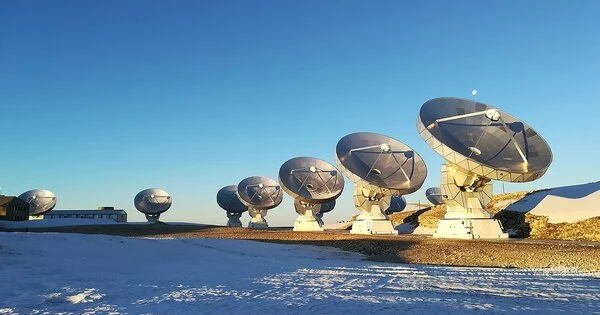The NOEMA radio telescope, located on the Plateau de Bure in the French Alps, is now equipped with twelve antennas, making it the most powerful radio telescope of its kind in the northern hemisphere. It is operated by the international institute IRAM, in which the Max Planck Society is involved. Max Planck President Martin Stratmann was among the guests at the telescope’s inauguration ceremony on September 30.
Eight years after the inauguration of the first NOEMA antenna in 2014, the large-scale European project is now complete. Thanks to its twelve 15-meter antennas, which can be moved back and forth on a specially developed rail system up to a distance of 1.7 kilometers long, NOEMA is a unique instrument for astronomical research.
With NOEMA, over 5,000 researchers from all over the world study the composition and dynamics of galaxies as well as the birth and death of stars, comets in our solar system or the environment of black holes. The observatory captures light from cosmic objects that has traveled to Earth for more than 13 billion years.
The telescope is equipped with highly sensitive receiving systems that operate close at the quantum limit. During observations, the observatory’s twelve antennas act as a single telescope—a technique called interferometry. After all the antennas have been pointed towards one and the same region of space, the signals they receive are combined with the help of a supercomputer. Their detailed resolution then corresponds to that of a huge telescope whose diameter is equal to the distance between the outermost antennas.
The respective arrangement of the antennas can extend over distances from a few hundred meters to 1.7 kilometers. The network thus functions like a camera with a variable lens. The further apart the antennas are, the more powerful is the zoom: the maximum spatial resolution of NOEMA is so high that it would be able to detect a mobile phone at a distance of over 500 kilometers.

NOEMA is one of the few radio observatories worldwide that can simultaneously detect and measure a large number of signatures—i.e., “fingerprints” of molecules and atoms. Thanks to these so-called multi-line observations, combined with high sensitivity, NOEMA is a unique instrument for investigating the complexity of cold matter in interstellar space as well as the building blocks of the university.
With NOEMA, over 5,000 researchers from all over the world study the composition and dynamics of galaxies as well as the birth and death of stars, comets in our solar system or the environment of black holes. The observatory captures light from cosmic objects that has traveled to Earth for more than 13 billion years.
NOEMA has already delivered a number of important scientific discoveries and findings. For example, the telescope has observed the most distant known galaxy known to date, which formed shortly after the Big Bang. In addition, NOEMA recently measured the temperature of the cosmic background radiation at a very early stage of the universe, a scientific first that should make it possible to trace the effects of dark energy driving the universe apart.





